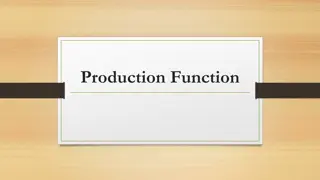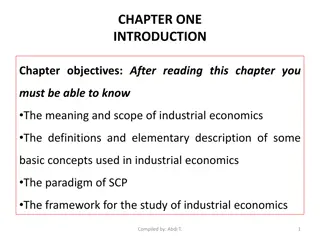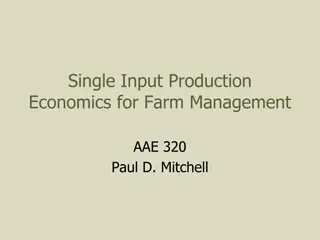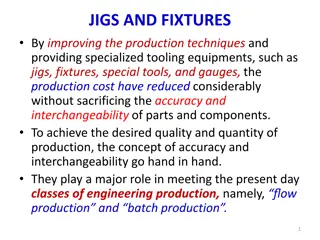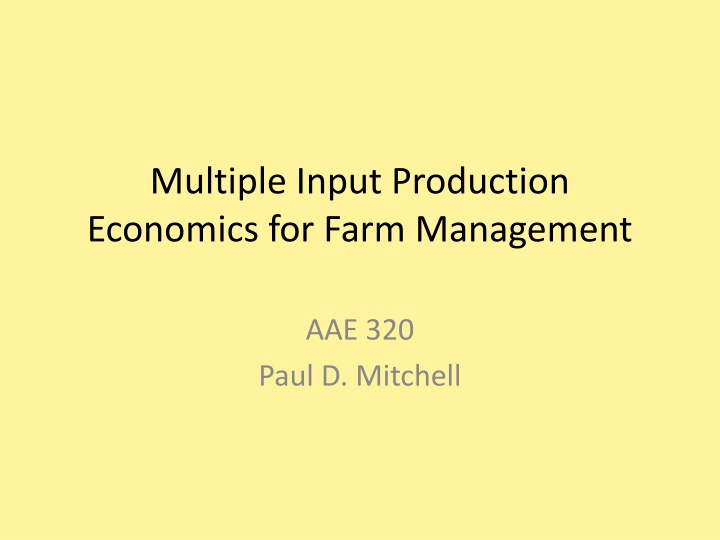
Multiple Input Production Economics for Farm Management
Explore the concept of multiple input production economics for farm management, focusing on the Equal Margin Principle and the use of partial derivatives in decision-making. Learn how to determine the optimal allocation of various inputs in agricultural production processes. Delve into the application of calculus and understand derivatives in multivariate functions to enhance farm productivity.
Download Presentation

Please find below an Image/Link to download the presentation.
The content on the website is provided AS IS for your information and personal use only. It may not be sold, licensed, or shared on other websites without obtaining consent from the author. If you encounter any issues during the download, it is possible that the publisher has removed the file from their server.
You are allowed to download the files provided on this website for personal or commercial use, subject to the condition that they are used lawfully. All files are the property of their respective owners.
The content on the website is provided AS IS for your information and personal use only. It may not be sold, licensed, or shared on other websites without obtaining consent from the author.
E N D
Presentation Transcript
Multiple Input Production Economics for Farm Management AAE 320 Paul D. Mitchell
Multiple Input Production Most agricultural production processes have more than one input, e.g., capital, labor, land, machinery, fertilizer, herbicides, insecticides, tillage, water, etc. How do you decide how much of each input to use when you are choosing more than one? We will derive the Equal Margin Principle and show its use to answer this question Focus is on substitution between inputs
Equal Margin Principle Will derive it using calculus so you see where it comes from Applies whether you use a function or not, so can apply Equal Margin Principle to the tabular form of the multiple input production schedule Multivariate calculus requires use of Partial Derivatives, so let s review
Partial Derivatives Derivative of function that has more than one variable What s the derivative of Q = f(x,y)? Depends on which variable you are talking about. Remember a derivative is the slope Derivative of Q = f(x,y) with respect to x is the slope of the function in the x direction Derivative of Q = f(x,y) with respect to y is the slope of the function in the y direction
Partial Derivatives Think of a hill; its elevation Q is a function of the location in latitude (x) and in longitude (y): Q = f(x,y) At any spot on the hill, defined by a latitude- longitude pair (x,y), the hill will have a slope in the x direction and in the y direction Slope in x direction: dQ/dx = fx(x,y) Slope in y direction: dQ/dy = fy(x,y)
Q Q=f(X,Y) Y X Source: Neoclassical Theories of Production on The History of Economic Thought Website: http://cepa.newschool.edu/het/essays/product/prodcont.htm
Partial Derivatives Notation: if have Q = f(x,y) First Partial Derivatives dQ/dx = fx(x,y) and dQ/dy = fy(x,y) Second (Own) Partial Derivative d2Q/dx2 = fxx(x,y) and d2Q/dy2 = fyy(x,y) Second Cross Partial Derivative d2Q/dxdy = fxy(x,y)
Partial Derivatives Partial derivatives are the same as regular derivatives, just treat the other variables as constants Q = f(x,y) = 2 + 3x + 6y 2x2 3y2 5xy When taking the derivative with respect to x, treat y as a constant and vice versa Q = f(x,y) = 2 + 3x + 6y 2x2 3y2 5xy fx(x,y) = 3 4x 5y Q = f(x,y) = 2 + 3x + 6y 2x2 3y2 5xy fy(x,y) = 6 6y 5x
Think Break #6 Give the 1st and 2nd derivatives [fx(x,y), fy(x,y),, fxx(x,y), fyy(x,y), fxy(x,y)] of each function: f(x,y) = 7 + 5x + 2y 5x2 4y2 11xy f(x,y) = 5 2x + y x2 3y2 + 2xy
Equal Margin Principle Given production function Q = f(x,y), find (x,y) to maximize (x,y) = pf(x,y) rxx ryy K FOC s: d /dx = 0 and d /dy = 0 and solve for pair (x,y) d /dx = pfx(x,y) rx = 0 d /dy = pfy(x,y) ry = 0 Just p x MPx = rx and p x MPy = ry Just MPx = rx/p and MPy = ry/p These still hold, but we have more Kind of like before
Equal Margin Principle Profit Maximization again implies p x MPx = rx and p x MPy = ry Note that p x MPx = rx depends on y and p x MPy = ry depends on x These are two equations and both must be satisfied, so rearrange by making the ratio pMP r pMP= r pMP pMP r r y x = x x x y y y
Equal Margin Principle Equal Margin Principle is expressed mathematically in two ways 1) MPx/rx = MPy/ry 2) MPx/MPy = rx/ry Ratio of MPi/ri must be equal for all inputs Ratio of MP s must equal input price ratio
Intuition for MPx/rx = MPy/ry Corn Example MPi is bu of corn per lb of N fertilizer (bu/lb) ri is $ per lb of N fertilizer ($/lb) MPi/ri is bu of corn per $ spent on N fertilizer (bu/lb) / ($/lb) = bu/$ MPi/ri is how many bushels of corn you get for the last dollar spent on N fertilizer MPx/rx = MPy/ry means use each input so that the last dollar spent on each input gives the same extra output
Intuition for MPx/MPy = rx/ry Corn Example MPx is bu of corn from last lb of N fert. (bu/lb N) MPy is bu of corn from last lb of P fert. (bu/lb P) MPx/MPy = (lbs P/lbs N) is how much P need if cut N by 1 lb and want to keep output constant Ratio of marginal products is the substitution rate between N and P in the production process Have not talked about substitution between inputs
Intuition for MPx/MPy = rx/ry Corn Example rx is $ per lb of N fertilizer ($/lb N) ry is $ per lb of P fertilizer ($/lb P) rx/ry is ($/lb N)/($/lb P) = lbs P/lbs N, or the substitution rate between N and P in the market MPx/MPy = rx/ry means use inputs so that the substitution rate between inputs in the production process is the same as the substitution rate between inputs in the market
Marginal Rate of Technical Substitution The ratio of marginal products (MPx/MPy) is the substitution rate between inputs in the production process MPx/MPy is called the Marginal Rate of Technical Substitution (MRTS): the input substitution rate at the margin for the production technology MRTS: If you cut X by one unit, how much must you increase Y to keep output the same Optimality condition MPx/MPy = rx/ry means set substitution rates equal
Equal Margin Principle Intuition MPx/rx = MPy/ry means use inputs so the last dollar spent on each input gives the same extra output at the margin Compare to p x MP = r or VMP = r MPx/MPy = rx/ry means use inputs so the substitution rate at the margin between inputs is the same in the production process as in the market place Compare to MP = r/p
Equal Margin Principle Graphical Analysis via Isoquants Isoquant ( equal-quantity ) plot or function representing all combinations of two inputs producing the same output quantity Intuition: Isoquants are the two dimensional contour lines of the three dimensional production hill First look at in Theory, then a Table
Isoquants in Theory Input Y ~ Output Q = Q Input X
Swine Feeding Operation: Output (hogs sold/year) Capital ($1,000) Labor (persons/year) 1 2 3 4 5 6 7 8 9 10 25 0.5 1 2 3 8 14.5 22 25 27.5 26 50 1.5 3 8 14.5 21.5 27.5 29 30 29.5 28 75 3 8 14.5 22 27.5 30 31 31 30.5 29.5 100 5 12 22 27.5 30 31 31.5 31.5 31.5 31 125 8 14.5 27.5 29 30.5 31.5 32 32 32 32 150 8 14.5 27.5 30 31 31.5 32 32.5 32.5 32.5 175 8 22 27.5 30 31 31.5 32 32.5 33 33 200 6.5 22 25 27.5 30 31 32 32.5 33 33.5
Swine feeding operation: Output (hogs sold/year) Capital ($1,000) Labor (persons/year) 1 2 3 4 5 6 7 8 9 10 25 0.5 1 2 3 8 14.5 22 25 27.5 26 50 1.5 3 8 14.5 21.5 27.5 29 30 29.5 28 75 3 8 14.5 22 27.5 30 31 31 30.5 29.5 100 5 12 22 27.5 30 31 31.5 31.5 31.5 31 125 8 14.5 27.5 29 30.5 31.5 32 32 32 32 150 8 14.5 27.5 30 31 31.5 32 32.5 32.5 32.5 175 8 22 27.5 30 31 31.5 32 32.5 33 33 200 6.5 22 25 27.5 30 31 32 32.5 33 33.5
35 30 25 20 Hogs/year (1,000) 15 10 5 S8 S7 S6 S5 0 S4 Labor (persons) S3 250 500 750 S2 1000 1250 1500 S1 1750 2000 Capital ($1,000)
Isoquants and MPx/MPy Isoquant Slope = Y/ X = Substitution rate between X and Y at the margin. If reduce X by the amount X, then must increase Y by the amount Y to keep output fixed Y Input Y X ~ Output Q = Q Input X
Isoquants and MPx/MPy Isoquant slope = dY/dX dY/dX = (dQ/dX)/(dQ/dY) dY/dX = MPx/MPy = Ratio of MP s Isoquant Slope = MRTS Need minus sign since marginal products are positive and slope is negative Input Y Y X ~ Output Q = Q Input X
Isoquants and MPx/MPy = rx/ry Isoquant slope ( MPx/MPy) is (minus) the substitution rate between X and Y at the margin Thus define minus the isoquant slope as the Marginal Rate of Technical Substitution (MRTS) Price ratio rx/ry is the substitution rate between X and Y (at the margin) in the market place Economically optimal use of inputs sets these substitution rates equal, or MPx/MPy = rx/ry
Isoquants and MPx/MPy = rx/ry Find the point of tangency between the isoquant and the input price ratio Kind of like the MP = r/p: tangency between the production function and input-output price ratio line Input Y ~ Output Q = Q Slope = MPx/MPy = rx/ry Input X
Soybean Meal (lbs) 10 15 20 25 30 35 40 45 50 55 60 65 70 Corn (lbs) 376.8 356.3 339.0 326.0 315.0 307.5 300.6 294.6 289.2 284.4 280.2 276.4 272.9 Soybean meal and corn needed for 125 lb feeder pigs to gain 125 lbs 375 350 325 Corn (lbs) 300 275 250 225 200 0 20 40 60 80 Soybean Meal (lbs) Which feed ration do you use?
MRTS = As increase Soybean Meal, how much can you decrease Corn and keep output constant? Soyb Meal 10 15 20 25 30 35 40 45 50 55 60 65 70 Corn 376.8 356.3 339.0 326.0 315.0 307.5 300.6 294.6 289.2 284.4 280.2 276.4 272.9 MRTS 4.10 3.46 2.60 2.20 1.50 1.38 1.20 1.08 0.96 0.84 0.76 0.70 Can t use MRTS = MPx/MPy since Q = 0 on an isoquant Use MRTS = Y/ X X = (SoyM2 SoyM1) Y = (Corn2 Corn1) = (294.6 300.6)/(45 40) = (284.4 289.2)/(55 50) Interpretation: If increase soybean meal 1 lb, decrease corn by 1.20 or 0.96 lbs and keep same gain on hogs
Soy Meal (lbs) 10 15 20 25 30 35 40 45 50 55 60 65 70 Corn (lbs) 376.8 356.3 339.0 326.0 315.0 307.5 300.6 294.6 289.2 284.4 280.2 276.4 272.9 Economically Optimal input use is where MRTS = input price ratio, or Y/ X = rx/ry (Same as MPx/MPy = rx/ry) Soybean Meal Price $176/ton = $0.088/lb MRTS P ratio 2.20 2.20 2.20 2.20 2.20 2.20 2.20 2.20 2.20 2.20 2.20 2.20 2.20 4.10 3.46 2.60 2.20 1.50 1.38 1.20 1.08 0.96 0.84 0.76 0.70 Corn Price $2.24/bu = $0.04/lb Ratio: 0.088/0.04 = 2.20 lbs corn/lbs soy Keep straight which is X and which is Y!!!
Intuition What does Y/ X = rx/ry mean? Ratio Y/ X is how much less Y you need if you increase X, or the MRTS Cross multiply to get Yry = Xrx Yry = cost savings from decreasing Y Xrx = cost increase from increasing X Keep sliding down the isoquant (decreasing Y and increasing with output staying the same) as long as the cost saving exceeds the cost increase Like a partial budget analysis of the cost changes (revenue doesn t change, as output doesn t change)
Main Point on MRTS When you have information on inputs needed to generate the same output, you can identify the optimal input combination Theory: (MRTS) MPx/MPy = rx/ry Practice: (isoquant slope) Y/ X = rx/ry Note how the input in the numerator and denominator changes between theory and practice
Think Break #7 Grain (lbs) Hay (lbs) MRTS price ratio The table is rations of grain and hay that put 300 lbs of gain on 900 lb steers. 1) Fill in the missing MRTS 2) If grain is $0.04/lb and hay is $0.03/lb, what is the economically optimal feed ration? 825 1350 900 1130 2.93 975 935 1050 770 2.20 1125 625 1.93 1200 525 1275 445 1.07
Summary Can identify economically optimal input combination using tabular data and prices Requires input data on the isoquant, i.e., different feed rations that generate the same amount of gain Again: use calculus to fill in gaps in the tabular form of isoquants
Types of Substitution Perfect substitutes: soybean meal & canola meal, corn & sorghum, wheat and barley Imperfect substitutes: corn & soybean meal Non-substitutes/perfect complements: tractors and drivers, wire and fence posts
Perfect Substitutes MRTS (slope of isoquant) is constant Examples: canola meal and soybean meal, or corn and sorghum in a feed ration Constant conversion between two inputs 2 pounds of canola meal = 1 pound of soybean meal: Cnla/ Soyb = 2 1.2 bushels of sorghum = 1 bu corn Srgm/ Corn = 1.2
Economics of Perfect Substitutes MRTS = rx/ry still applies MRTS = k: Y/ X = Cnla/ Soyb = 2 If rx/ry < k, use only input x soybean meal < twice canola meal price soyb meal $200/cwt, cnla meal $150/cwt If rx/ry > k, use only input y soybean meal > twice canola meal price soyb meal $200/cwt, cnla meal $90/cwt If rx/ry = k, use any x-y combination
Use only Canola Meal rx/ry > 2 Perfect Substitutes: Graphics Use any combination of Canola or Soybean Meal 2 rx/ry = 2 1 Canola Meal Use only Soybean Meal rx/ry < 2 Soybean Meal
Economics of Imperfect Substitutes This the case we already did! Input Y Input X
Perfect Complements, or Non-Substitutes No substitution is possible The two inputs must be used together Without the other input, neither input is productive, they must be used together Tractors and drivers, fence posts and wire, chemical reactions, digger and shovel Inputs used in fixed proportions 1 driver for 1 tractor
Economics of Perfect Complements MRTS is undefined, the price ratio rx/ry does not identify the optimal combination Leontief Production Function Q = min(aX,bY): Marginal products of inputs = 0 Either an output quota or a cost budget, with the fixed input proportions, define how much of the inputs to use
Perfect Complements: Graphics Price ratio does not matter rx/ry > 2 Drivers rx/ry < 2 Tractors
Multiple Input Production with Calculus Use calculus with production function to find the optimal input combination General problem we ve seen: Find (x,y) to maximize (x,y) = pf(x,y) rxx ryy K Will get FOC s, one for each choice variable, and SOC s are more complicated
Multiple Input Production with Calculus If price of output p = 10, price of x (rx) = 2 and price of y (ry) = 3 Max 10(7 + 9x + 8y 2x2 y2 2xy) 2x 3y 8 FOC1: 10(9 4x 2y) 2 = 0 FOC2: 10(8 2y 2x) 3 = 0 Find the (x,y) pair that satisfies these two equations Same as finding where the two lines from the FOC s intersect
FOC1: 10(9 4x 2y) 2 = 0 FOC2: 10(8 2y 2x) 3 = 0 1) Solve FOC1 for x 88 40x 20y = 0 40x = 88 20y x = (88 20y)/40 = 2.2 0. 5y 2) Substitute this x into FOC2 and solve for y 77 20y 20x = 0 77 20y 20(2.2 0.5y) = 0 77 20y 44 + 10y = 0 33 10y = 0, or 10y = 33, or y = 3.3 3) Calculate x: x = 2.2 0. 5y = 2.2 0.5(3.3) = 0.55
Second Order Conditions SOC s are more complicated with multiple inputs, must look at curvature in each direction, plus the cross direction (to ensure do not have a saddle point). 1) Own second derivatives must be negative for a maximum: xx < 0, yy < 0 (both > 0 for a minimum) 2) Another condition: xx yy ( xy)2 > 0
FOC1: 10(9 4x 2y) 2 = 0 FOC2: 10(8 2y 2x) 3 = 0 Second Derivatives 1) xx: 10( 4) = 40 2) yy: 10( 2) = 20 3) xy: 10( 2) = 20 SOC s 1) xx = 40 < 0 and yy = 20 < 0 2) xx yy ( xy)2 > 0 ( 40)( 20) ( 20)2 = 800 400 > 0 Solution x = 0.55 and y = 3.3 is a maximum
Milk Production M = 25.9 + 2.56G + 1.05H 0.00505G2 0.00109H2 0.00352GH M = milk production (lbs/week) G = grain (lbs/week) H = hay (lbs/week) Milk $14/cwt, Grain $3/cwt, Hay $1.50/cwt What are the profit maximizing inputs? (Source: Heady and Bhide 1983)
Milk Profit Function (G,H) = 0.14( 25.9 + 2.56G + 1.05H 0.00505G2 0.00109H2 0.00352GH) 0.03G 0.015H FOC s G = 0.14(2.56 0.0101G 0.00352H) 0.03 = 0 H = 0.14(1.05 0.00218H 0.00352G) 0.015 = 0 Alternative: jump to optimality conditions MPG = rG/p and MPH = rH/p MPG = 2.56 0.0101G 0.00352H = rG/p = 0.214 MPH = 1.05 0.00218H 0.00352G = rH/p = 0.107
Solve FOC1 for H: 2.56 0.0101G 0.00352H = 0.214 2.346 0.0101G = 0.00352H H = (2.346 0.0101G)/0.00352 H = 666 2.87G Substitute this H into FOC2 and solve for G: 1.05 0.00218H 0.00352G = 0.107 0.943 0.00218(666 2.87G) 0.00352G = 0 0.943 1.45 + 0.00626G 0.00352G = 0 0.00274G 0.507 = 0 G = 0.507/0.00274 = 185 lbs/week
Substitute this G into the equation for H H = 666 2.87G H = 666 2.87(185) H = 666 531 = 135 lbs/week Check SOC s GG = (0.14)0.0101 = 0.001414 < 0 HH = (0.14)0.00218 = 0.000305 < 0 GH = (0.14)0.00352 = 0.000493 GG HH ( GH)2 = 1.88 x 10-7 > 0 SOC s satisfied for a maximum



